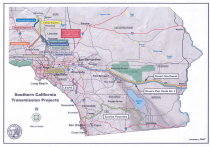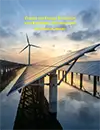Center for Energy Efficiency and Renewable Technologies
Center for Energy Efficiency and Renewable Technologies
Providing global warming solutions for California and the West.

Join CEERT Email Newsletter
Transmission Planning and Development
Transmission is to renewable energy resources what the transcontinental railroad was to opening up the West. We need to connect California’s renewable resource-rich regions—wind from Tehachapi, geothermal and wind from the Imperial Valley, and solar power from the Mojave Desert and the Central Valley—to the large coastal urban load centers of the state where it is needed. Making this vital connection will require a series of massive, multibillion-dollar investments in new transmission infrastructure. In conjunction with the California Energy Commission, we have been promoting a unique stakeholder collaboration project to expedite planning and development of vital transmission projects.
Recent Developments:
CEERT has partnered with GridLab and consultant Ed Smeloff to convene a series of biweekly calls among NGOs, developers, trade associations, utilities, communication strategists, and legislative offices to report on transmission-related activities at the California Independent System Operator (CAISO), the California Public Utilities Commission (CPUC), and the legislature.
With the release of the CAISO’s 2023-2024 Draft Transmission Plan in April, as well as the Draft Study Plan for the 2024-2025 Transmission Planning Process, CEERT and GridLab have written a new trans-mission report titled, “Transmission in 2024: CEERT’s Review of the Challenges Ahead.” The report also covers updates to the revision of the CPUC’s General Order 131-D and the interconnection queue reform process; transmission needs in the Central Valley, where the state is anticipating abundant build-out of solar generation, and in the LA Basin, where gas reliance will need to be greatly reduced; and a review of advanced transmission technologies, such as grid-enhancing technologies and advanced conductors. CEERT is in the process of planning a webinar following the release of the report, anticipated for May 20. Further information will be sent out to the CEERTify list when available.
Advanced Transmission Technologies (ATTs)
Last year, CEERT began vetting the use of advanced transmission technologies (ATTs), including grid-enhancing technologies (GETS) and advanced conductors, on the state’s existing transmission and distribution system. CEERT and others had met with the Governor’s Office in December to raise awareness of these technologies and the benefits they bring, including increased line capacity, which reduces congestion and allows for the interconnection of more renewables to the grid; enhanced grid reliability and resiliency, decreasing risks of outages and wildfires while enabling the rapid rerouting of electrons to unaffected lines during complications; and substantial cost savings through increased performance, reduced curtailment, and a more affordable, near-term alternative to building new transmission for the same capacity. While California will still need to significantly build out its transmission system, ATTs can be quickly and cost-effectively deployed onto the existing grid to maximize grid assets.
CEERT and the Clean Power Campaign (CPC) have been leading the “Unlock the Grid” Coalition, which meets weekly to discuss advocacy and legislative efforts on the use of these technologies. The Coalition is supporting two bills: the first is AB 3246 by Assemblymember Garcia, which would offer a permitting incentive to investor-owned utilities (IOUs) for reconductoring projects that use an advanced conductor, by exempting these projects from a permit to construct and instead going through the CPUC’s Tier 2 Advice Letter process. The second bill is SB 1006 by Senator Padilla, which would require the IOUs to submit to the CPUC a joint report on the use of GETs that prioritizes cost-effectiveness and increasing capacity for new renewable energy resources, as well as require each utility to submit an evaluation of which lines can be reconductored with advanced conductors every four years. The Coalition is also monitoring AB 2779 by Assemblymember Petrie-Norris, which is currently in spot form; conversations about what amendments should look like are underway.
Reducing Reliance on Fossil-Fueled Power Plants
To further gas-plant shutdowns, CEERT is advocating for the zonal focus of transmission into the LA Basin and Greater Bay Area, where the bulk of polluting fossil fueled power plants are located. Through our statewide transmission work, including comments to the CAISO and our transmission reports, we have extensively advocated for projects that bring substantial renewable energy into urban load pockets.
For the first time, the CAISO’s 20-Year Outlook has begun to study which gas plants can be turned off in the 2040-2045 timeframe, prioritizing the oldest, most polluting plants, located in or closest to disadvantaged communities. Power-flow mapping has identified the necessary clean energy projects that will be needed to replace capacity that has historically been met by these gas plants, with the bulk of resources mapped from the Central Valley, New Mexico, Nevada, and Wyoming. Most of the plants identified for shutdown are located in the Greater Bay Area, with a substantial amount also coming out of the LA Basin. The final 20-Year Outlook is anticipated to be released at the May 22-23 CAISO Board of Governors meetings. The resulting projects will need to begin the planning phase immediately to raise capital and decide on a timeline for transformer upgrades. CEERT plans to stay informed on the progress of these projects and will continue to push for the shutdown of all fossil-fueled power plants by 2045.

